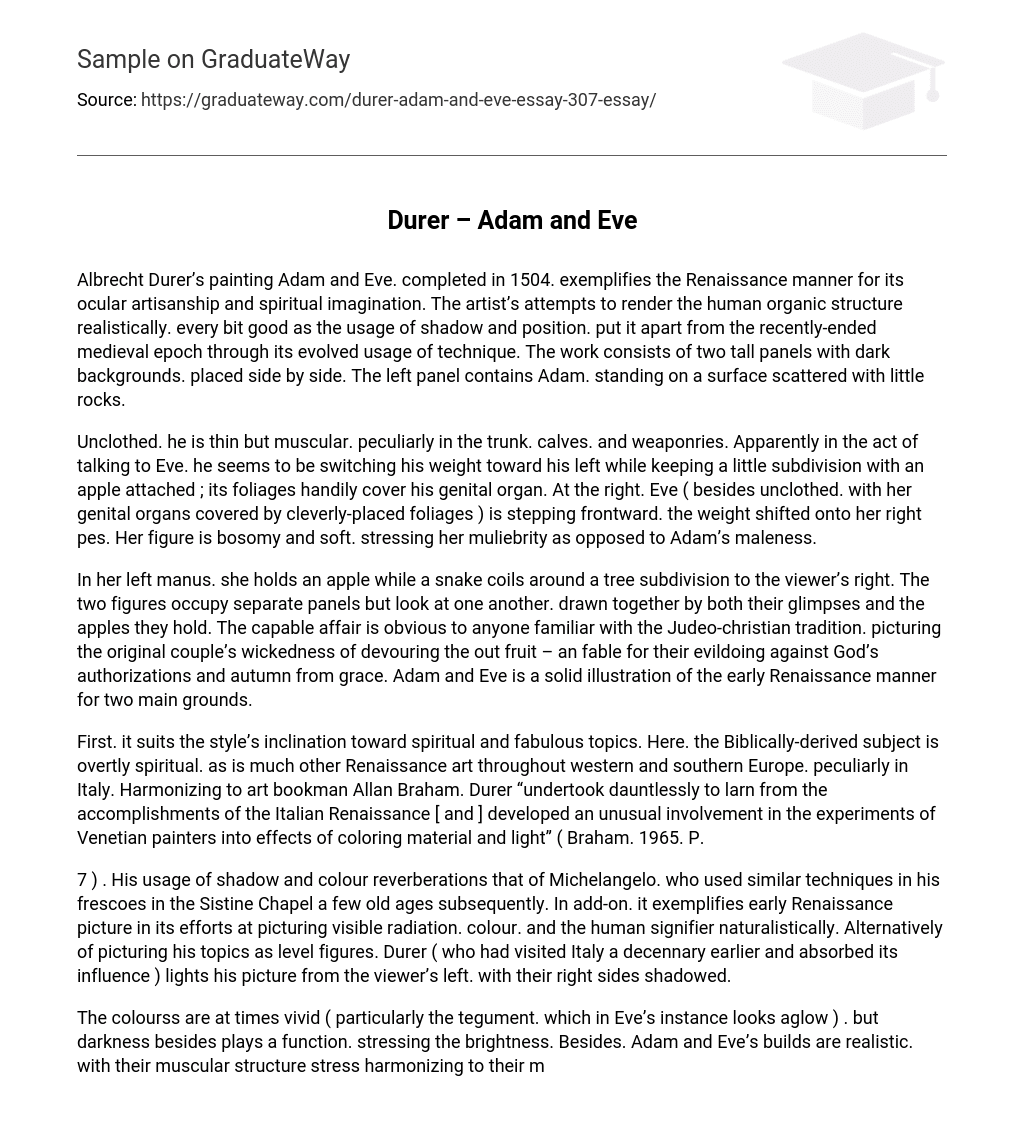Albrecht Dürer’s painting “Adam and Eve”, completed in 1504, exemplifies the Renaissance style for its visual craftsmanship and spiritual imagination. The artist’s attempts to render the human body realistically, as well as the use of shadow and perspective, sets it apart from the recently ended medieval era through its evolved usage of technique. The work consists of two tall panels with dark backgrounds, placed side by side. The left panel contains Adam, standing on a surface scattered with small rocks.
Unclothed, he is thin but muscular, particularly in the trunk, calves, and arms. Apparently in the act of speaking to Eve, he seems to be shifting his weight toward his left while holding a small branch with an apple attached; its leaves conveniently cover his genitalia. On the right, Eve (also unclothed, with her genitalia covered by cleverly placed leaves) is stepping forward, the weight shifted onto her right foot. Her figure is bosomy and soft, emphasizing her femininity as opposed to Adam’s masculinity.
In her left hand, she holds an apple while a snake coils around a tree branch to the viewer’s right. The two figures occupy separate panels but look at each other, drawn together by both their gazes and the apples they hold. The subject matter is obvious to anyone familiar with the Judeo-Christian tradition, portraying the original couple’s sin of eating the forbidden fruit – a fable for their wrongdoing against God’s commands and fall from grace. “Adam and Eve” is a solid example of the early Renaissance style for two main reasons.
First, it fits the style’s inclination toward spiritual and mythical topics. Here, the biblically derived subject is overtly spiritual, as is much other Renaissance art throughout western and southern Europe, particularly in Italy. According to art scholar Allan Braham, Dürer “undertook dauntlessly to learn from the skills of the Italian Renaissance [and] developed an unusual interest in the experiments of Venetian painters into effects of colour and light” (Braham, 1965, p. 7).
His use of shadow and color reverberates that of Michelangelo, who used similar techniques in his frescoes in the Sistine Chapel a few years later. In addition, it exemplifies early Renaissance painting in its efforts to depict light, color, and the human form naturalistically. Instead of depicting his subjects as flat figures, Dürer (who had visited Italy a decade earlier and absorbed its influence) illuminates his painting from the viewer’s left, with their right sides shadowed.
The colors are at times vivid (especially the skin, which in Eve’s case looks aglow), but darkness also plays a role, emphasizing the brightness. Also, Adam and Eve’s bodies are realistic, with their muscular structure emphasizing according to their movements; they are not stiff or unnaturally contorted but seem to be captured in motion (as their billowing hair attests). In his other works (particularly his paintings but also his wood engravings), Dürer pays the same attention to shadowing, three-dimensionality, and anatomical correctness.
For example, “The Virgin in Prayer” (1518) resembles other Renaissance artists’ works in its use of bright colors, properly placed shadows, and attention to anatomical detail (particularly the hands) – the same elements that Michelangelo, a contemporary, strove to achieve. Scholar Francis Russell writes that, unlike other contemporary depictions of Adam and Eve, Dürer’s “are unique, going beyond the sinuousness of the Gothic and the severe classicism… and their freedom from any formula is the essence of their charm” (Russell, 1967, p. 119).
In this work, Durer works within the Italian Renaissance manner, integrating the same attention to spiritual subject, realistic portraiture of the human body, and particular attention to light and shadow that his southern contemporaries had done. Though he began as a woodcutter in a traditional German manner, his pictures exemplify the then-emerging manner that accompanied Europe’s rational metamorphosis.
WORKS CITED:
- Anonymous. (2006). Albrecht Durer. Retrieved 18 April 2006 from https://en.wikipedia.org/wiki/Albrecht_Durer.
- Braham, A. (1965). Durer. London: Spring Books.
- Russell, F. (1967). The World of Durer, 1471-1528. New York: Time Incorporated.





